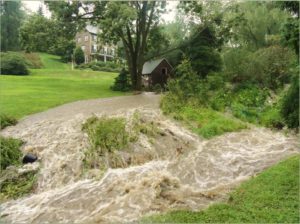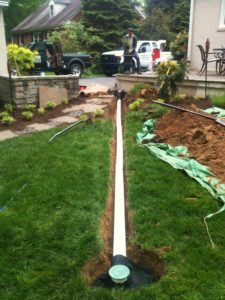Rain, Rain, Go Away? In the mid-Atlantic region, we are actually lucky to get the rainfall that we do. Our “normal” weather patterns of wet springs, hot summers, cool falls, and cold winters have caused the evolution of our uniquely mid-Atlantic flora and fauna, or plants and animals.
But there can be problems with our rainy springs, including flooding, erosion and poor water quality, and many of our land management practices exacerbate these problems. These problems can be directly related to the amount of hard, or impervious surface that covers an area. Roofs, roads, and parking lots are all impervious. Water that would normally soak into the ground now runs across these surfaces, picking up speed, as well as pollutants, and then quickly enters our streams and rivers.
Flooding and Erosion: Traditional landscape practices direct water from downspouts and other hard surfaces away from buildings, and off site. This water now becomes someone else’s problem. This practice also causes large amounts of water to enter our waterways very rapidly, causing flash flooding and other problems downstream. At the same time, water does not get a chance to enter our groundwater, resulting in lower water tables during times of drought.
Environmentally thoughtful landscaping captures rainwater on site, and treats it as a resource. Using this water for lawns and gardens just makes sense.
One way to do this is to bury downspouts and release the water away from the house in a garden bed or lawn using pop up emitters. The emitters are flush with the ground when not in use, almost disappearing from view, and “pop up” out of the ground when water is forced out of them during a rain storm.
When released into a garden bed, surrounding plants should be selected that can handle large amounts of water, as well as some periods of drought. Many plants native to our area can do just that.
Pollution: Since 1977, the Clean Water Act has helped clean up our streams and rivers by stopping direct dumping into our waterways. But many of our streams remain polluted. This is because of indirect, or nonpoint source pollution. Fertilizers, engine oils, pet waste and trash are all examples of nonpoint source pollution that have a large impact on our water quality.
A thoughtful and judicious use of fertilizers and pesticides is a good first step towards keeping our waterways clean. A turf program that includes adding organic material to the soil, aerating, and over-seeding increases the health of the turf without the use of pesticides and heavy fertilizers. We also advocate determining how much lawn you really need. A property with areas of healthy turf balanced with beautiful plantings has many benefits to the environment as well as increased property values.
The good news is that we can all help to reduce erosion and flooding, and contribute to improving our water quality by enacting simple changes in the way we manage our properties. We can do this by slowing water down, keeping it on site, and keeping it clean.
So this spring, instead of saying to yourself “Rain, Rain, Go Away”, remember that we are lucky for the rain we have. Maybe a better saying to keep in mind is “We all live downstream”.
Check back soon for how to capture water in a “rain garden”.



